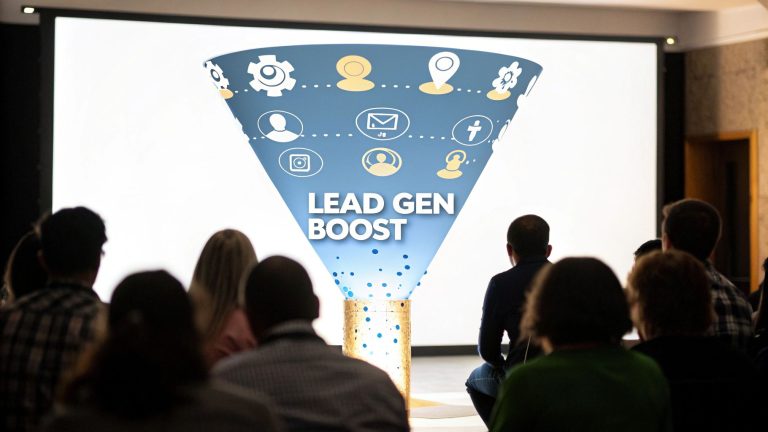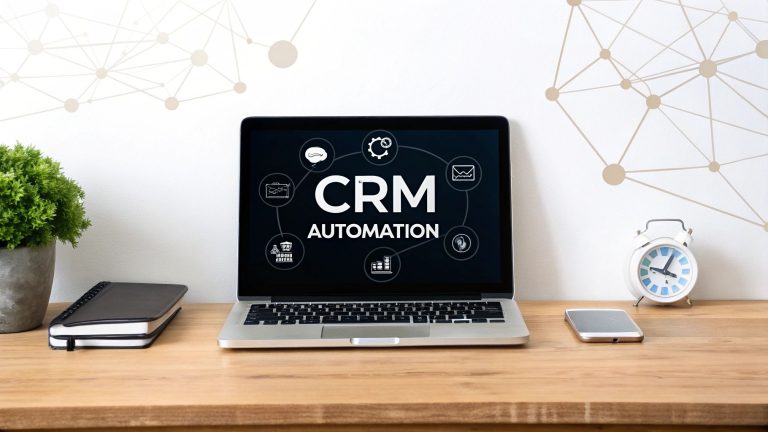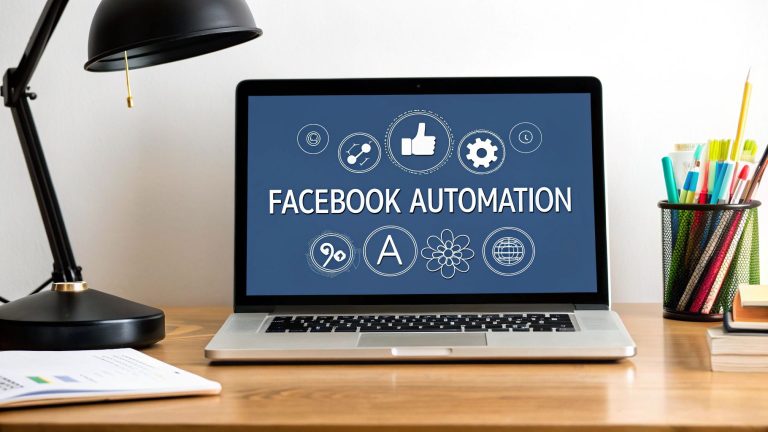7 Winning Tips for Lead Generation for Marketing Agencies
In the competitive landscape of 2025, a steady stream of high-quality leads isn't just a goal; it's the lifeblood of a thriving marketing agency. Yet, many agencies find themselves so focused on generating results for clients that their own pipeline runs dry. The challenge is clear: how do you build a predictable, scalable system for lead generation that showcases your expertise without consuming all your resources? It's a classic "cobbler's children have no shoes" problem, but one that directly impacts your ability to grow and scale.
This article moves beyond generic advice to provide a comprehensive roadmap for sustainable growth. We will dissect seven proven strategies for lead generation for marketing agencies, offering actionable steps, real-world examples, and the strategic insights needed to attract your ideal clients consistently. You will learn how to implement effective systems for:
- Content Marketing & SEO
- LinkedIn Outbound & Social Selling
- Referral and Partnership Programs
- High-Converting Lead Magnets
- Webinars and Virtual Events
- Targeted Paid Advertising
- Strategic Cold Email Outreach
To effectively tune your agency's growth engine and position yourself in the market, it's crucial to understand the nuances of a B2B SEO agency model. This framework helps define your service offerings and target audience, which is the foundational step before deploying the lead generation tactics we will cover. Whether you're a startup agency or an established player, these methods will equip you to build a robust growth engine and secure a dominant market position. Let's dive into the strategies that will fill your pipeline.
1. Content Marketing & SEO
Content marketing and Search Engine Optimization (SEO) form a powerful, long-term strategy for sustainable lead generation for marketing agencies. This approach focuses on creating and distributing valuable, relevant, and consistent content to attract and retain a clearly defined audience, ultimately driving profitable customer action. Instead of outbound pushing, you pull potential clients in by demonstrating your expertise and solving their problems.
When an agency consistently publishes high-quality blog posts, in-depth whitepapers, data-driven case studies, and comprehensive guides, it builds trust and authority. Potential clients searching for solutions to their marketing challenges will find your agency, not your competitors. This method establishes your brand as a go-to resource long before a prospect is ready to make a purchasing decision.
Why It Works for Agencies
This strategy is particularly effective for marketing agencies because your product is expertise. Content is the most direct way to showcase that expertise at scale. Pioneers like HubSpot built their entire empire on this model, offering immense value through their blog and free tools, which in turn generates millions of visitors and a steady stream of high-quality leads. Similarly, Moz became synonymous with SEO by creating unparalleled educational resources that their target audience of marketers relies on daily.
How to Implement This Strategy
Successfully leveraging content and SEO requires a strategic, not haphazard, approach.
-
Focus on Pillar Pages and Topic Clusters: Build your content strategy around your core service offerings. Create a comprehensive "pillar page" for each service (e.g., "The Ultimate Guide to PPC for SaaS Companies"). Then, create shorter "cluster" blog posts that address specific subtopics (e.g., "Negative Keyword Strategies for Google Ads," "How to Optimize PPC Landing Pages") and link them back to the pillar page. This structure signals your authority to search engines and provides clear user navigation.
-
Conduct Intent-Driven Keyword Research: Use tools like Ahrefs or SEMrush to find what your ideal clients are searching for. Target keywords that signal a problem you can solve, such as "how to improve email marketing ROI" or "best b2b social media strategies." This ensures you attract traffic that is more likely to convert.
-
Embed Clear Calls-to-Action (CTAs): Every piece of content should guide the reader to the next step. This doesn't always have to be "Contact Us." Offer a downloadable case study, a free consultation, or a newsletter subscription. The key is to capture their information and move them into your sales funnel. Learn more about how to capture these prospects with our complete guide to organic lead generation strategies.
-
Repurpose and Distribute: Don't let your content die after one post. Turn a blog post into a video, an infographic, a series of social media updates, or a podcast episode. This maximizes your reach and caters to different content consumption preferences, amplifying your lead generation efforts without reinventing the wheel.
2. LinkedIn Outbound & Social Selling
LinkedIn outbound and social selling represent a targeted, relationship-first approach to B2B lead generation for marketing agencies. This strategy moves beyond cold, impersonal outreach and focuses on using LinkedIn to identify ideal clients, connect with decision-makers, and nurture relationships through genuine interaction and value-sharing. It’s about building a professional network that views you as a credible expert before you ever pitch your services.
By leveraging the platform's vast professional data, you can pinpoint prospects with surgical precision, engaging them not with a hard sell, but with insightful content and meaningful conversation. This method positions your agency as a helpful partner, making the transition from prospect to client a natural and seamless process.
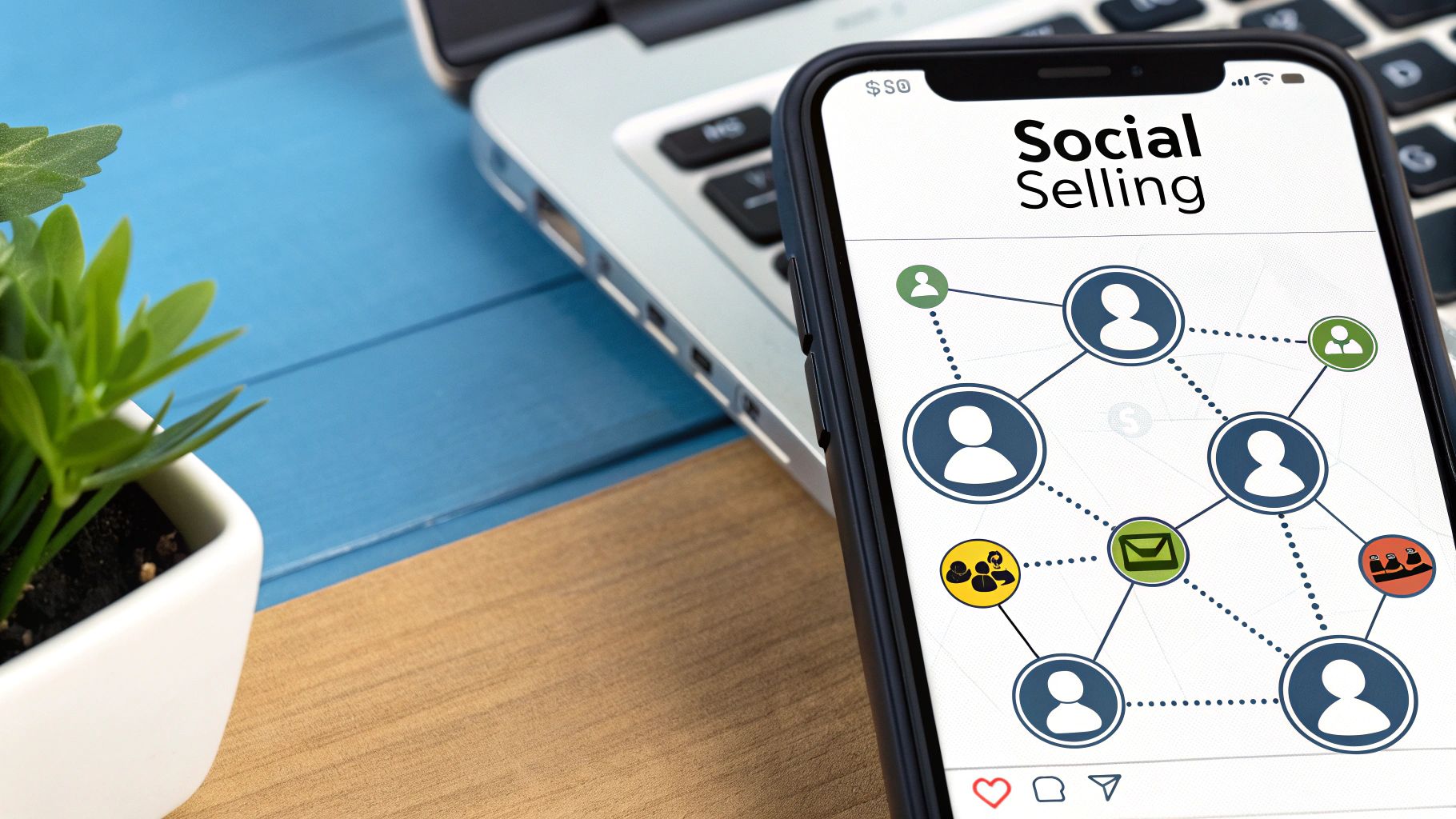
Why It Works for Agencies
This strategy is highly effective for marketing agencies because business decisions are made by people, and LinkedIn is where those people gather professionally. Social selling pioneers like Jill Rowley have proven that modern buyers are more informed and research-driven, making relationship-building critical. For agencies, this means you can directly engage with CMOs, marketing directors, and founders, establishing rapport and demonstrating your value long-term.
Large enterprises like Salesforce have generated millions in revenue by integrating social selling into their B2B sales process. Similarly, agency leaders like Gary Vaynerchuk leverage their personal brands on LinkedIn to attract a constant flow of high-value inbound inquiries, showcasing the power of consistent, authentic engagement.
How to Implement This Strategy
A successful LinkedIn strategy requires a blend of personal branding, strategic networking, and consistent value delivery. It’s a marathon, not a sprint.
-
Optimize Your Personal & Company Profiles: Your LinkedIn profile is your digital storefront. Ensure your personal profile has a professional headshot, a benefit-driven headline (e.g., "Helping SaaS Brands Scale with Performance Marketing"), and a detailed "About" section that functions as a landing page. Your company page should mirror this professionalism, showcasing case studies and employee expertise.
-
Identify and Connect Strategically: Use LinkedIn Sales Navigator for advanced filtering to find decision-makers in your target industries and company sizes. When sending a connection request, always include a personalized message. Reference a shared connection, a recent post they made, or a common interest to stand out from generic requests.
-
Engage with Value, Not a Sales Pitch: The core of social selling is giving before you ask. Share valuable content, comment thoughtfully on your prospects' posts, and offer insights in relevant industry groups. The goal is to become a familiar, trusted name in their feed. A great framework is the 4-1-1 rule: for every six posts, four should be educational content from others, one should be your own educational content, and one can be a soft promotional post.
-
Nurture Relationships into Conversations: After establishing a connection and engaging over time, transition the conversation to a more direct channel. You can send a message like, "I've really enjoyed your insights on [topic]. I've noticed many companies in your space face challenges with [problem]. Is this something you're exploring?" This moves the relationship from public engagement to a private, business-focused discussion.
3. Referral and Partnership Programs
Referral and partnership programs offer a systematic way to generate high-quality leads by leveraging the power of existing relationships and trust. This strategy turns your network of satisfied clients and complementary businesses into a proactive, lead-generating engine. Instead of relying solely on cold outreach, you tap into warm introductions, which often have significantly higher conversion rates and shorter sales cycles.
This approach is built on the simple principle of trusted recommendations. When a happy client refers a new prospect or a partner business sends a lead your way, that prospect arrives with a pre-existing level of confidence in your agency’s capabilities. This immediately sets you apart from competitors and accelerates the journey from initial contact to a signed contract.
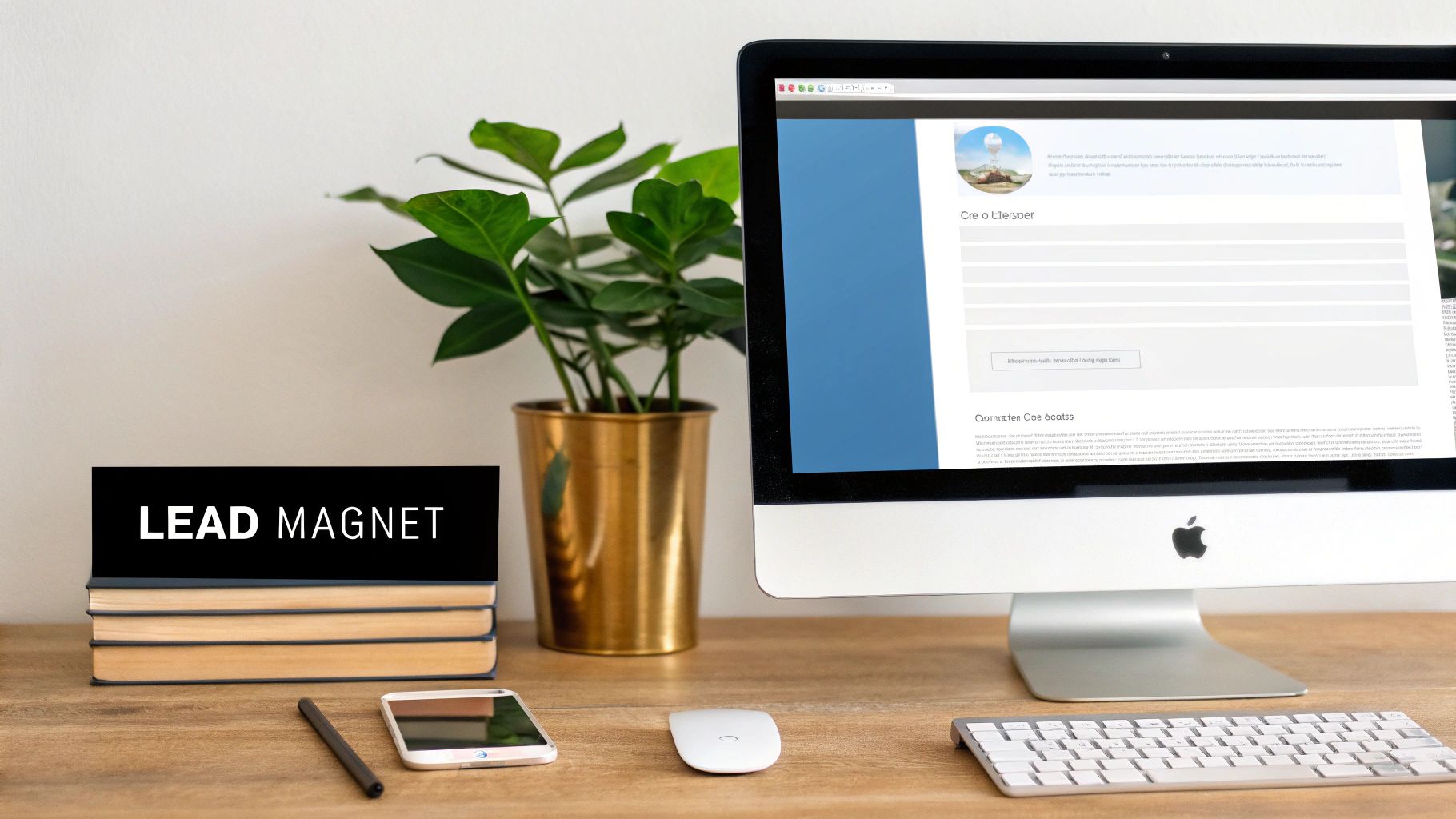
Why It Works for Agencies
This strategy is exceptionally potent for agencies because trust is the currency of service-based businesses. A referral is a direct endorsement of your results and client service. HubSpot’s legendary Partner Program is a prime example, creating a massive ecosystem where agencies refer clients to HubSpot's software, and HubSpot, in turn, provides leads and resources back to the agencies. On a smaller scale, a local marketing agency partnering with a web development firm or a business consultant creates a symbiotic relationship where each party generates valuable, pre-qualified leads for the other.
How to Implement This Strategy
A successful referral program requires more than just hoping clients will spread the word; it needs structure and clear incentives.
-
Formalize the Process: Don't leave referrals to chance. Create a clear, simple process for clients and partners to submit a lead. This could be a dedicated landing page, a simple form, or a designated point of contact. The easier you make it, the more referrals you will receive.
-
Offer Compelling, Two-Sided Incentives: Motivate both the referrer and the new client. For example, offer your existing client a 10% commission or a free month of service for a successful referral, and give the new client a 10% discount on their first invoice. This creates a win-win-win scenario.
-
Identify and Nurture Strategic Partnerships: Actively seek out non-competing businesses that serve your ideal client profile. This includes web developers, accountants, business coaches, and IT service providers. Schedule regular check-in meetings to stay top-of-mind and discuss potential cross-promotional opportunities.
-
Track Everything and Show Gratitude: Use a CRM or a simple spreadsheet to track where referrals come from and their status in your sales pipeline. This helps measure ROI and identify your best advocates. Always express genuine gratitude for every referral, whether it closes or not, to reinforce the behavior. A systematic referral program is one of the most effective ways to generate leads and is a key tactic for reducing your overall customer acquisition cost.
4. Lead Magnets and Landing Pages
Lead magnets and dedicated landing pages are a foundational tactic for effective lead generation for marketing agencies. This strategy revolves around creating a high-value, downloadable resource (like an ebook, template, or checklist) and offering it to potential clients for free in exchange for their contact information, typically a name and email address. The exchange happens on a landing page designed for one single purpose: conversion.
This approach works by providing immediate, tangible value. Instead of just asking for a consultation, you are solving a specific, pressing problem for your target audience, which positions your agency as a helpful expert from the very first interaction. It’s a direct value exchange that builds trust and populates your sales funnel with qualified prospects who have already shown interest in your area of expertise.
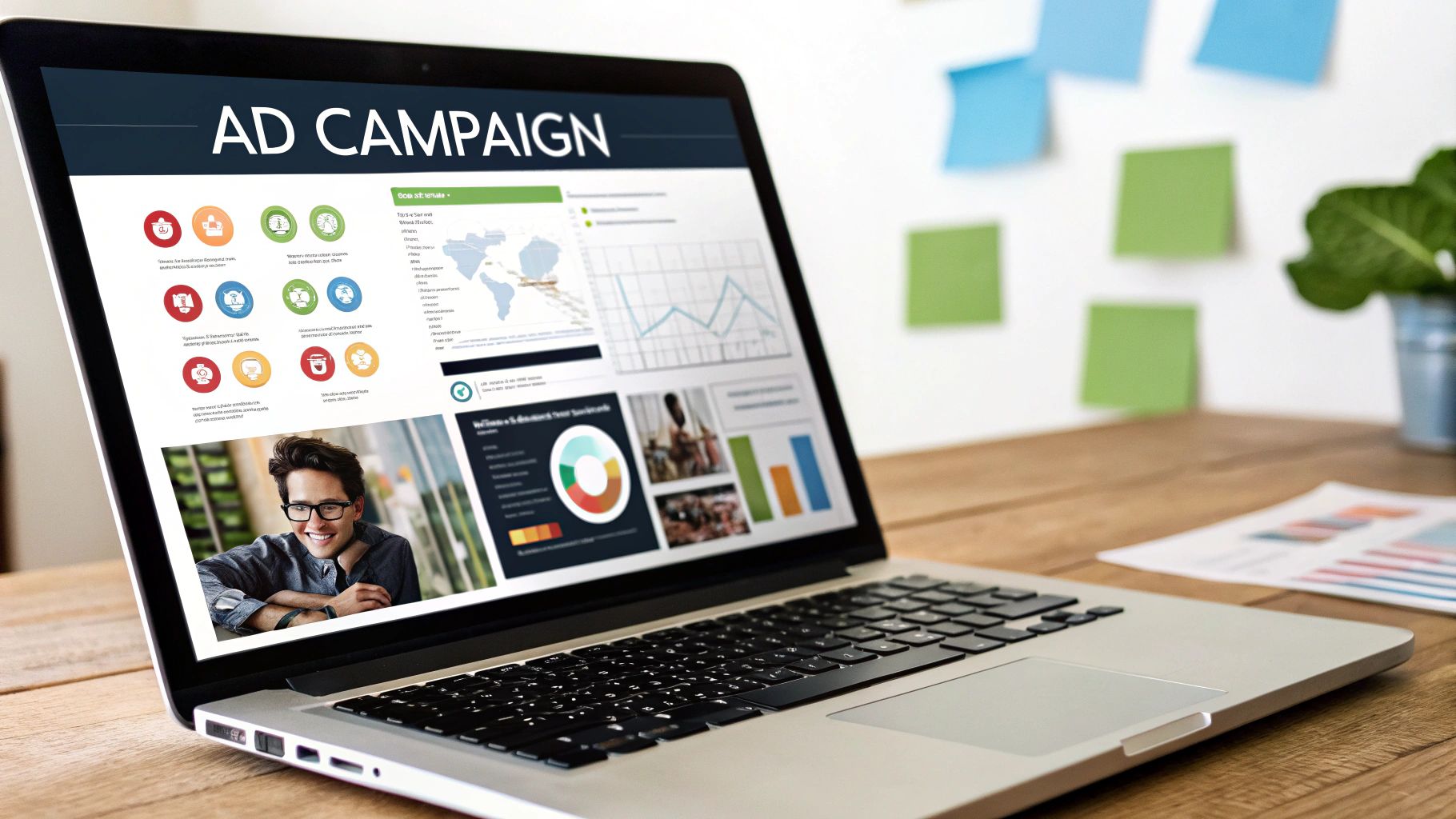
Why It Works for Agencies
This method is incredibly powerful for agencies because it directly addresses the knowledge gap that potential clients have. Companies like HubSpot and DigitalMarketer pioneered this model, building massive email lists by offering comprehensive guides, templates, and toolkits. For an agency, offering a "Free Social Media Content Calendar Template" or an "Industry-Specific SEO Audit Checklist" is a low-friction way to attract businesses actively seeking marketing help.
These leads are often more qualified than cold traffic. Someone who downloads a guide on "How to Structure a B2B Google Ads Campaign" is very likely in the market for PPC services, making them a warm prospect for your sales team to nurture. This method consistently generates a high volume of top-of-funnel leads that can be segmented and nurtured into clients.
How to Implement This Strategy
A successful lead magnet strategy requires more than just creating a PDF. It needs to be a seamless, persuasive experience from start to finish.
-
Solve a Specific Pain Point: Your lead magnet must offer a quick win. Don't create a vague "Guide to Digital Marketing." Instead, focus on a niche problem like "The 5-Step Checklist for a High-Converting eCommerce Product Page" or "A Template for Calculating Marketing ROI." The more specific the solution, the more compelling the offer.
-
Optimize Your Landing Page for Conversion: The landing page should be minimalist and focused. It needs a powerful headline that clearly states the benefit of the lead magnet, compelling copy explaining what the user will get, a visually appealing image of the resource, and a short, simple form. Remove all navigation and distractions to keep the visitor focused on the single action of downloading.
-
Promote Your Lead Magnet: Create the best resource in the world, but it won't generate leads if no one sees it. Promote your lead magnet through paid social ads, include it in pop-ups on relevant blog posts, add it to your email signature, and have your team share it on LinkedIn. For paid campaigns, a key strategy for maximizing ROI is to discover how to reduce CPA with video variants, ensuring more cost-effective lead acquisition.
-
Implement an Immediate Follow-Up Sequence: Once a prospect submits the form, your work has just begun. Deliver the resource immediately via a thank you page and an automated email. Then, enroll them in a brief, value-packed email nurture sequence that provides more helpful content and gently guides them toward booking a consultation.
5. Webinars and Virtual Events
Webinars and virtual events are a dynamic and interactive form of lead generation for marketing agencies. This strategy involves hosting live or pre-recorded online seminars to educate a target audience on a specific topic. By providing immense value upfront, agencies can demonstrate their expertise, build trust, and capture high-intent leads who voluntarily register to learn from them. It's a method that turns a cold audience into warm prospects by establishing a direct, personal connection in a scalable way.
Instead of just telling potential clients you're an expert, you are actively showing them. A well-executed webinar on a topic like "Advanced LinkedIn Ad Strategies for B2B" or "How to Triple Your E-commerce Sales with Email Automation" positions your agency as a thought leader. Attendees not only gain actionable insights but also get a firsthand look at your agency's knowledge and communication style, making the sales conversation much smoother.
Why It Works for Agencies
This approach is exceptionally powerful for agencies because it directly addresses the client's primary concern: "Can this agency actually solve my problem?" Webinars provide the proof. Industry pioneers like Russell Brunson of ClickFunnels and marketing educator Amy Porterfield have built multi-million dollar enterprises by mastering the webinar format to educate and convert audiences. Similarly, B2B SaaS companies often partner with agencies for joint webinars, pooling their audiences and credibility to generate a massive volume of qualified leads.
How to Implement This Strategy
A successful webinar requires more than just a presentation; it demands a strategic approach to promotion, engagement, and follow-up.
-
Choose a High-Impact, Niche Topic: Don't host a generic "Intro to Digital Marketing" webinar. Instead, focus on a specific, urgent pain point your ideal client faces. For example, "How to Prepare Your E-commerce Store for the Holiday Rush" is much more compelling than "E-commerce Marketing Tips." This specificity attracts a more qualified and engaged audience.
-
Promote Extensively and Strategically: Your webinar is only effective if people attend. Promote it across all your channels: email lists, social media (both organic and paid), your website homepage, and through partnerships. Create a dedicated landing page for registration that clearly outlines the value attendees will receive. To ensure your lead magnets and landing pages are highly effective, it's crucial to follow key landing page design best practices for optimal conversion.
-
Design for Engagement, Not Just Presentation: Avoid a static, one-way lecture. Incorporate interactive elements like live polls, Q&A sessions, and chat discussions to keep your audience engaged. The goal is to create a two-way conversation that builds rapport and allows you to understand the audience's specific challenges in real-time.
-
Include a Clear and Compelling Offer: A webinar should always lead to a next step. Towards the end, present a clear call-to-action (CTA). This could be a special offer on a service, a free consultation, a discovery call, or an exclusive resource download. Make the offer time-sensitive to encourage immediate action.
-
Follow Up with Everyone: Your work isn't done when the webinar ends. Send the recording to all registrants, including those who didn't attend. Segment your follow-up emails based on whether someone attended, how long they stayed, and if they engaged with your offer, tailoring your message for maximum relevance and impact.
6. Paid Advertising (Google Ads, Facebook, LinkedIn)
Paid advertising offers a direct and highly controllable method for generating leads by placing your agency in front of potential clients at the exact moment they are searching for solutions. Unlike organic methods that require time to build momentum, paid campaigns on platforms like Google Ads, Facebook, and LinkedIn can drive immediate traffic and inquiries. This strategy allows you to precisely target specific demographics, industries, and job titles, ensuring your marketing budget is spent on reaching the most relevant audience.
For marketing agencies, running paid ads for your own business serves a dual purpose. It not only generates high-intent leads but also acts as a powerful, real-time case study of your skills. When a prospect sees your sophisticated ad campaign and clicks through to a perfectly optimized landing page, you are demonstrating your expertise before you even have a conversation. This "show, don't tell" approach builds instant credibility and attracts clients who understand the value of paid media.
Why It Works for Agencies
This strategy is exceptionally effective because it leverages an agency's core competency: creating and managing high-performing ad campaigns. You are using your own services to grow your business. For instance, WordStream has famously used Google Ads to become a dominant force, capturing leads from businesses actively looking for PPC management solutions. Similarly, many B2B agencies use LinkedIn Ads to target C-level executives in specific verticals, delivering hyper-relevant messaging that cuts through the noise.
How to Implement This Strategy
A successful paid advertising strategy for lead generation requires more than just launching an ad; it demands meticulous planning and optimization.
-
Create Dedicated, High-Converting Landing Pages: Never send paid traffic to your homepage. Each campaign should have a dedicated landing page with a single, clear call-to-action (CTA). The messaging on the page must mirror the ad copy to create a seamless user experience, reinforcing the value proposition and guiding the visitor toward conversion.
-
Master Conversion Tracking and Attribution: Before spending a single dollar, ensure your conversion tracking is set up perfectly. Use Google Tag Manager, the Meta Pixel, and the LinkedIn Insight Tag to accurately measure form submissions, phone calls, and other key actions. This data is critical for understanding your cost-per-lead and optimizing campaigns for profitability.
-
Implement Sophisticated Retargeting: Most visitors won't convert on their first visit. Use retargeting campaigns to stay in front of people who have visited your website but didn't inquire. You can serve them different ads, like a case study or a special offer, to nurture their interest and bring them back into your funnel when they are ready.
-
Focus on Intent and Pain Points in Ad Copy: Your ads should speak directly to the challenges your ideal client faces. Instead of generic copy like "We Are a Full-Service Marketing Agency," use problem-focused headlines like "Tired of Wasting Your Ad Spend? We Fix Leaky PPC Funnels." This approach grabs attention and pre-qualifies your leads. To get started with one of the most powerful platforms, check out our in-depth guide with this Facebook Ads Manager tutorial.
7. Cold Email Outreach
Cold email outreach, when executed with precision and personalization, is a direct and highly effective strategy for lead generation for marketing agencies. This method involves systematically contacting potential clients via email who have not previously expressed interest in your agency. The key to success is shifting the focus from a hard sales pitch to providing immediate value, solving a specific problem, or initiating a meaningful conversation.
Unlike spam, strategic cold outreach is hyper-targeted, well-researched, and centered on the recipient's needs. It allows an agency to bypass gatekeepers and communicate directly with decision-makers, presenting a compelling reason to connect. For a marketing agency, a well-crafted cold email is also a live demonstration of its communication and persuasion skills, serving as an initial proof of concept for its expertise.
Why It Works for Agencies
This strategy is powerful for agencies because it's proactive and scalable. You aren't waiting for leads to find you; you are creating opportunities by identifying ideal clients and reaching out with a relevant message. The model popularized by Aaron Ross in his book Predictable Revenue showed how Salesforce built a massive outbound sales machine on this foundation. Agencies can replicate this by targeting businesses with an obviously poor online presence, offering a free website audit, or reaching out to companies that just received funding and need to scale their marketing.
How to Implement This Strategy
A successful cold email campaign is a science, not a guessing game. It requires a systematic approach to stand out in a crowded inbox.
-
Research and Personalize at Scale: Use tools like LinkedIn Sales Navigator or industry directories to build a list of ideal prospects. Before outreach, identify a specific, genuine reason to connect. This could be a recent company announcement, a new product launch, or a poorly optimized ad campaign you noticed. Reference this "hook" in the first line of your email to show you've done your homework.
-
Craft a Compelling, Value-First Message: Your email should be short, scannable, and focused entirely on the recipient. Avoid generic pitches. Instead, lead with value. For example, instead of saying "We do SEO," try "I noticed your top competitor outranks you for '[key term]' and found a specific reason why. Happy to share my one-page analysis." This positions you as a helpful expert, not just another vendor.
-
Focus on the Next Small Step: The goal of the first email is not to book a meeting or close a deal; it's to get a reply. End with a simple, low-friction call-to-action like, "Is this a priority for you right now?" or "Would you be open to seeing the brief analysis I put together?" This makes it easy for the prospect to engage.
-
Implement Strategic Follow-ups: Most replies come from follow-up emails, not the initial one. Create a sequence of 2-4 brief, polite follow-ups that offer additional value or a different angle. Space them out over a couple of weeks. Remember to use email verification tools to clean your list and maintain a high sender reputation, which is crucial for deliverability.
Lead Generation Strategies Comparison
| Strategy | Implementation Complexity 🔄 | Resource Requirements ⚡ | Expected Outcomes 📊 | Ideal Use Cases 💡 | Key Advantages ⭐ |
|---|---|---|---|---|---|
| Content Marketing & SEO | Moderate to High 🔄🔄 | Continuous content creation, SEO tools ⚡ | Long-term organic traffic, authority growth 📊 | Building thought leadership, inbound leads | Cost-effective, builds trust, scalable content |
| LinkedIn Outbound & Social Selling | High 🔄🔄🔄 | Time-intensive personalized outreach ⚡ | Direct connection to decision-makers 📊 | B2B lead generation, relationship nurturing | High response rates, built-in social proof |
| Referral and Partnership Programs | Moderate 🔄🔄 | Relationship management, incentives ⚡ | High conversion, warm qualified leads 📊 | Leveraging existing clients and partners | Low acquisition cost, trust-based leads |
| Lead Magnets and Landing Pages | Moderate 🔄🔄 | Content creation, landing page setup ⚡ | Qualified leads, email list growth 📊 | Lead capture, email marketing growth | Immediate value, measurable, scalable |
| Webinars and Virtual Events | High 🔄🔄🔄 | Preparation, production, promotion ⚡ | Highly engaged, qualified leads 📊 | Demonstrating expertise, interactive lead gen | Builds trust quickly, repurposable content |
| Paid Advertising (Google, FB, LinkedIn) | Moderate to High 🔄🔄🔄 | Budget for ads, optimization expertise ⚡ | Immediate traffic, rapid lead generation 📊 | Scalable lead gen, targeted campaigns | Precise targeting, fast results, detailed analytics |
| Cold Email Outreach | Moderate 🔄🔄 | Research, personalization, CRM tools ⚡ | Direct access, measurable results 📊 | Personalized outreach to decision-makers | Cost-effective, scalable, value-driven communication |
Building Your Agency’s Unstoppable Lead Generation Machine
The journey through the landscape of lead generation for marketing agencies reveals a fundamental truth: there is no single, magic-bullet solution. The path to a consistently full pipeline isn't paved by one stellar campaign or a single lucky break. Instead, sustainable growth is the result of building a sophisticated, interconnected, and relentlessly optimized lead generation system.
The seven strategies we've explored are not isolated tactics; they are the essential pillars of this system. Think of them as gears in a powerful engine. When they turn in unison, they create momentum that is far greater than the sum of its parts. Your high-value blog post (Content & SEO) becomes the perfect shareable asset for a targeted LinkedIn campaign. The insights from that post can be expanded into a compelling webinar, which is then promoted using precise paid advertising. The attendees from that webinar can be added to a nurturing cold email sequence. This is the flywheel effect in action.
From Strategy to System: Key Takeaways
Mastering lead generation for marketing agencies requires a strategic shift in perspective. You must move from merely executing tactics to architecting a comprehensive growth framework. The most successful agencies do not just run ads or send emails; they build self-sustaining ecosystems where each activity amplifies the others.
Here are the critical takeaways to focus on:
- Integration Over Isolation: Your most powerful advantage comes from blending strategies. The content you develop for SEO should fuel your social selling on LinkedIn. The partnerships you build can co-host webinars. Your paid ads can drive traffic directly to high-converting lead magnets. Always ask, "How can this effort support another channel?"
- The Compounding Power of Assets: Strategies like SEO and content marketing are not quick fixes; they are long-term investments in digital real estate. Every piece of content you publish, every backlink you earn, and every keyword you rank for builds your agency's authority and generates leads on autopilot for years to come.
- Precision and Personalization: The era of "spray and pray" is definitively over. Whether it's hyper-targeting on LinkedIn, segmenting your cold email lists, or creating niche lead magnets, success hinges on delivering the right message to the right person at the right time. Generic outreach gets ignored; personalized value gets responses.
- Efficiency as a Competitive Edge: Your team's most valuable resource is their time. Every minute spent on manual, repetitive tasks like downloading CSVs from ad platforms or manually transferring lead data is a minute not spent on strategy, client relationships, or closing deals. Automation isn't a luxury; it's a core operational necessity for scaling.
Your Actionable Next Steps
Feeling overwhelmed is a natural response to the sheer volume of options. The key is to start small, be deliberate, and build momentum. Do not try to implement all seven strategies at once.
- Conduct a Quick Audit: Review the seven strategies and identify your agency's biggest weakness or most significant opportunity. Where is your lead flow the weakest?
- Choose One Primary and One Secondary Focus: Select one strategy to master over the next 90 days (e.g., LinkedIn Outbound). Then, choose a secondary, supporting strategy that complements it (e.g., creating a new lead magnet specifically for your LinkedIn audience).
- Define and Measure Your KPIs: For your chosen strategy, set clear, measurable goals. This could be "generate 15 qualified sales calls from LinkedIn" or "achieve a 20% conversion rate on our new landing page." What gets measured gets managed.
- Automate Early and Often: From the very beginning, look for opportunities to automate the process. This is especially critical for high-volume channels like paid ads, where lead leakage can silently kill your ROI.
Ultimately, building a powerful lead generation machine is what separates thriving agencies from those that are constantly struggling. It's the engine that powers your growth, provides stability in uncertain times, and gives you the freedom to be selective about the clients you partner with. Embrace these principles, commit to consistent execution, and you will construct an unstoppable force for your agency's future.
Ready to eliminate the manual work that slows down your growth? LeadSavvy Pro instantly and automatically sends your Facebook Ad leads directly to your email, CRM, or Google Sheets, ensuring you can follow up in seconds, not hours. Stop losing valuable leads to delays and start building your unstoppable agency with a free trial of LeadSavvy Pro.


